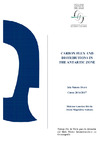Identificador persistente para citar o vincular este elemento:
https://accedacris.ulpgc.es/handle/10553/74768
| DC Field | Value | Language |
|---|---|---|
| dc.contributor.advisor | González Dávila, Melchor | - |
| dc.contributor.advisor | Santana Casiano, Juana Magdalena | - |
| dc.contributor.author | Simón Otero, Iria | - |
| dc.date.accessioned | 2020-10-15T10:43:52Z | - |
| dc.date.available | 2020-10-15T10:43:52Z | - |
| dc.date.issued | 2017 | en_US |
| dc.identifier.uri | https://accedacris.ulpgc.es/handle/10553/74768 | - |
| dc.description.abstract | The high increasing trend of CO2 emissions is one of the most threatening factors of climate change. Although atmospheric CO2 concentrations are already historically high, the ocean uptake (about 30% of the emissions) is mitigating its effects. Despite of the ocean value controlling climate change, not all the areas contribute to the CO2 sink the same. The Southern Ocean is responsible for the 43% of the total ocean anthropogenic carbon sink. However, the efficiency of this carbon uptake relies on physical and chemical phenomena as vertical mixing or thermal effect. In this paper, we assess the evolution of anthropogenic carbon content in the Atlantic section of Southern Ocean between 2008 and 2014. For this aim we used available data from three different cruises. We found that the diminution in the uptake trend between 1980 and 2006 is still noticeable in deep waters. However, subsuperficial waters showed an increase in anthropogenic carbon content of 1.8±0.8 mol m-2 y-1, as a consequence of the reinforcement of carbon uptake since 2006. Finally, the formation of Antarctic Intermediate Water proved to be an efficient mechanisms of CO2 transport into the interior ocean. | en_US |
| dc.language | eng | en_US |
| dc.subject | 251002 Oceanografía química | en_US |
| dc.subject.other | Anthropogenic carbon | en_US |
| dc.subject.other | CO2 fugacity | en_US |
| dc.subject.other | Southern Ocean | en_US |
| dc.subject.other | Atlantic section | en_US |
| dc.title | Carbon flux and distribution in the Antarctic zone | en_US |
| dc.type | info:eu-repo/semantics/masterThesis | en_US |
| dc.type | MasterThesis | en_US |
| dc.contributor.departamento | Departamento de Química | en_US |
| dc.contributor.facultad | Facultad de Ciencias del Mar | en_US |
| dc.investigacion | Ciencias | en_US |
| dc.type2 | Trabajo final de máster | en_US |
| dc.description.notas | Máster en Oceanografía ; 2016-2017 | en_US |
| dc.utils.revision | Sí | en_US |
| dc.identifier.matricula | TFT-42336 | es |
| dc.identifier.ulpgc | Sí | en_US |
| dc.contributor.buulpgc | BU-BAS | en_US |
| dc.contributor.titulacion | Máster Universitario en Oceanografía por la Universidad de Cádiz, la Universidad de Las Palmas de Gran Canaria y la Universidad de Vigo | es |
| item.fulltext | Con texto completo | - |
| item.grantfulltext | restricted | - |
| crisitem.advisor.dept | GIR IOCAG: Química Marina | - |
| crisitem.advisor.dept | IU de Oceanografía y Cambio Global | - |
| crisitem.advisor.dept | Departamento de Química | - |
| crisitem.advisor.dept | GIR IOCAG: Química Marina | - |
| crisitem.advisor.dept | IU de Oceanografía y Cambio Global | - |
| crisitem.advisor.dept | Departamento de Química | - |
| Appears in Collections: | Trabajo final de máster Restringido ULPGC | |
Page view(s)
113
checked on Jan 26, 2025
Download(s)
22
checked on Jan 26, 2025
Google ScholarTM
Check
Share
Export metadata
Items in accedaCRIS are protected by copyright, with all rights reserved, unless otherwise indicated.
